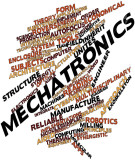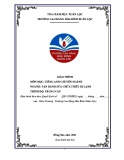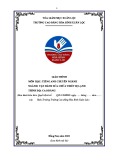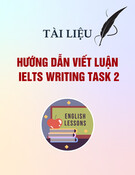
Trêng ®¹i häc kü thuËt c«ng nghiÖp
Khoa khoa häc c¬ b¶n
Bé m«n: Ngo¹i ng÷
ng©n hµng c©u hái thi kÕt thóc häc phÇn
häc phÇn: tiÕng anh kü thuËt
(3 tÝn chØ)
Dïng cho ®µo t¹o bËc ®¹i häc theo häc chÕ tÝn chØ
cho kü s chÊt lîng cao ngµnh c¬ khÝ chÕ t¹o m¸y
Th¸i nguyªn – 8/2007
1. NỘI DUNG ĐÁNH GIÁ THI KẾT THÚC HỌC PHẦN
UNIT 1: Engineering – what’s it all about?

Reading: Introduction
Language study: deals with/ is concerned with
Word study; Word stress
Writing: Gap fiiling
UNIT 2: Engineering materials
Reading: Scanning tables
Language study: Making definitions
Writing: Adding information to text
UNIT 3: Mechanisms
Reading: Scanning a text
Writing: Ways of linking ideas 1
Language study: Dealing with technical terms
Speaking practice
UNIT 4: Forces in engineering
Reading 1: Predicting
Reading 2: Grammar links in text
Language study: the Present passive
UNIT 5: Portable generator
Reading: Reading diagrams
Language study: Cause and effect 2
Word study:Verbs with –ize/ise
Writing: Writing process 3, Sequence and location
UNIT 6: Disc brake
Reading: Combining skills
Language study: Verbs with up and down
Word study: Verbs +- en
Writing: Explaining an operation
Technical reading: Water-based hydraulics
UNIT 7: Corrosion
Reading: Skimming
Language study: Cause and effect 3
Speaking practice: Exchanging information
Technical reading: Corrosion of materials
UNIT 8: Graphs
Language study: Describing graphs
Word study: Common verbs in engineering
Writing: Describing graphs (task 6 & 7)
Technical reading: Properties and applications of carbon
steels

UNIT 9: Robotics
Reading: Transferring information
Language study: Concession even if and although.
Technical reading: Stepper motors
UNIT 10: Applying for a job
Reading: Understanding job advertisements
Speaking: Role play
Writing: Writing a CV and letter of application
Technical reading: Company structures
2. PHƯƠNG PHÁP ĐÁNH G IÁ
-Tự lu ận
-Hình th ức th i viết (th ời gian:90 ’)
3. NGUYÊN TẮC TỔ HỢP CÂU HỎI ĐỂ LÀM ĐỀ TH I KẾT THÚC HỌC
PHẦN
-Nguyên tắc:
+ Kết hợp giữa các phần câu hỏi
+ Một đề thi bao gồm 4 loại câu hỏi: 5 câu loại
1a, 5 câu loại 1b, 10 câu loại 2, 10 câu loại 3, 10
câu loại 4
+ Câu hỏi loại 3 được tổ hợp từ các loại 3a, 3b,
3c, 3d, 3e; mỗi loại 1 câu.
-Thang điểm: Điểm toàn bài: 10 điểm
+ Câu hỏi loại 1: 2,5 điểm ( 5 câu đọc hiểu, mỗi câu
0,25;5 câu True/False,mỗi câu 0,25 điểm)
+ Câu hỏi loại 2: 2,5điểm, mỗi câu 0,25 điểm
+ Câu hỏi loại 3: 2,5điểm, mỗi câu 0,25 điểm
+ Câu hỏi loại 4: 2,5điểm, mỗi câu 0,25 điểm
-Loại câu hỏi:
oCâu hỏi loại 1: Read the following passage and do the
tasks below.
1a. Answer the questions
1b. Are these sentences True (T) or
False (F) ?
oCâu hỏi loại 2: Choose the best word to fill in the
gaps.
oCâu hỏi loại 3: Rewrite the following sentences
without changing the meanings.
oCâu hỏi loại 4: Give the correct form of the word in
brackets.
4. NGÂN HÀNG CÂU HỎI
4.1.Câu hỏi loại 1
1. The four- stroke cycle
Induction stroke with the inlet valve open and the
exhaust valve shut, the piston moves down the cylinder
create a partial vacuum. This partial vacuum draws in the
atomized fuel from the carburettor into the cylinder.

Compression stroke w ith both the in le t and exhaust
valve closed , the piston m oves up the cylinder, com pressing
the fue l m ixture . Just before the end of the stroke , an
electric spark across the points of the sparking plug
ign ites the petro l and air m ixture .
Power stroke Both valves remain closed. During the tiny
interval of time required for flame to establish itself, the
piston has reached its highest position in the cylinder. The
gas generated by the burning fuel now expands rapidly,
driving the piston down the cylinder. This downward push is
converted into a rotary movement by the connecting rod and
crankshaft. A water jacket contained within the cylinder
walls helps to conduct away the heat generated during this
burning and thus keeps the engine cool.
Exhaust stroke The exhaust valve opens but the inlet
valve remains shut. The piston moves up the cylinder,
pushing the exhaust gas out through the exhaust valve. With
the completion of the exhaust stroke the cycle begins again.
a. Answer the questions:
1. Say which word in the text has the same meaning as “a
flash of light”
2. Find in the text which word means “produced”
3. In the text which word has the same meaning as “closed”
4. In power stroke what causes the piston to move down the
cylinder?
5. There are three differences between Induction and
Exhaust stroke. What are they?
b.Are these sentences True or False ? Write T (True) or F
( False) at the end of the sentence.
1. During the process of induction stroke, the inlet valve
and exhaust valve open at the same time.
2. The fuel mixture is compressed by the piston.
3. The piston moves down the cylinder when the gas expands
quickly.
4. Some water is placed outside the cylinder to conduct
away the heat and keep the engine cool.
5. After the exhaust gas has been totally released, a new
cycle begins.
2. Consumption of energy resources, (e.g. turning on a
light) is apparently harmless. However, producing that
energy requires resources and contributes to air and water
pollution. Many electric power plants burn coal oil or
natural gas in order to generate electricity for energy
needs. While burning these fossil fuels produces a readily
available and instantaneous supply of electricity, it also

generates air pollu tan ts includ ing carbon d ioxide (CO 2),
su lfu r dioxide and triox ide (SO x) and nitrogen oxides (NO x).
Carbon dioxide is an im portant greenhouse gas w hich is
thought to be responsib le for som e fraction of the rap id
increase in globa l w arm ing.
Burning fossil fue ls for electricity generation also
re leases trace m etals such as beryllium , cadm ium , chrom ium ,
copper, m anganese, m ercury, nicke l, and silve r in to the
environm ent, w hich also act as pollu tan ts. Certa in renew able
energy technolog ie s do not pollu te the environm ent in the
sam e w ays, and there fo re can help contribu te to a cleaner
energy futu re fo r the w orld . Renew able energy technolog ies
availab le fo r electric ity production in clude biofue ls, solar
pow er, tidal pow er, w ind turb ines, hydroe lectric pow er, etc.
How ever, serious environm ental concerns have been
articu la ted by several environm ental activ ists regard ing
these m odes of electric ity generation . Accord ing to them ,
som e pollu tion is invariab ly produced during the m anufactu re
and re tirem ent of the m ateria ls associa ted w ith the
m achinery used in these technolog ie s. A centra l w ay to avoid
dow nsides of expanding energy production is energy
conservation .
a. Answer the questions:
1. Does consumption of energy make the air and water
polluted?
2. To generate electricity what are burned by many
electric power plants?
3. What air pollutant generated while burning fossil
fuels has a great contribution to global warming?
4. What trace metals that pollute the environment are
released while burning fossil fuels?
5. What do renewable energy technologies consist of?
b. Are these sentences True or False ? Write T (True) or F (
False) at the end of the sentence.
1. The production of energy is polluting air and water.
2. Sulfure dioxide is the air pollutant which partly
contributes to global warming.
3. Some kinds of trace metals appear in the process of
burning fossil fuels for electricity generation.
4. According to several environment activists,renewable
energy technologies do not pollute the environment any
more.
5. Energy conservation helps to avoid the problem of
energy production.
3. Jet engines

![Bài giảng Anh văn chuyên ngành Điện - Điện tử [mới nhất]](https://cdn.tailieu.vn/images/document/thumbnail/2025/20250806/vijiraiya/135x160/84061754472437.jpg)










![Tài liệu Từ vựng tiếng Anh Trung cấp [mới nhất]](https://cdn.tailieu.vn/images/document/thumbnail/2025/20250913/nguyentuan250421@gmail.com/135x160/99491757910839.jpg)
![Tài liệu Từ vựng Tiếng Anh theo chủ đề [mới nhất]](https://cdn.tailieu.vn/images/document/thumbnail/2025/20250913/namdhuet@gmail.com/135x160/83251757753810.jpg)



![Tài liệu Từ vựng tiếng Anh cho bé [chuẩn nhất/mới nhất]](https://cdn.tailieu.vn/images/document/thumbnail/2025/20250731/huadaithesang2509@gmail.com/135x160/18631754013896.jpg)








